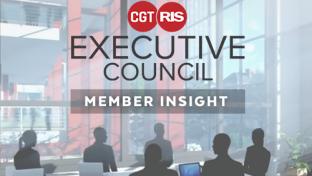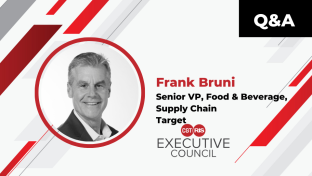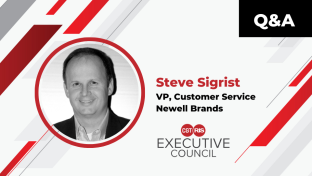Uncovering Supply Chain’s True Game-Changer: Up Close with SAS’ Richard Widdowson

With more than three decades of global retail experience, Richard Widdowson can say with confidence that things in business are not always as clear-cut as they seem — but that doesn’t mean the industry couldn’t stand to simplify a bit.
Widdowson, who’s held supply chain and merchandising leadership roles at such companies as Walmart, CVS, JCPenney, Save-A-Lot and other mass market sellers, now currently serves as VP, global retail and CPG solutions at SAS. This retail foundation has afforded him a valuable perspective about what it truly takes when it comes to forging stronger bonds between retail and consumer goods companies.
We chatted with Widdowson, who’s a member of the CGT/RIS Executive Council, about retail’s shifting landscape, the power of collaboration, and the challenges that come with operating within a living, breathing — and ever-changing — supply chain.
RIS:Your background carries deep retail experience. What are some of the ways you draw from this experience in doing business with consumer goods companies today?
Anybody that has spent any time working in the retail industry knows that the “customer always comes first.” For retailers, taking care of the customer means having products available to sell for the whole purpose of generating revenue. This sounds obvious, however, taking care of the end customer is underpinned by the collaboration between consumer goods companies and retailers.
I learned the power of collaboration early on in my career through working and living in many parts of the world thus exposing myself to new cultures and discovering the value of diversity. I’ve had the good fortune to work with exceptional people at some great consumer goods companies. I never met anyone who didn’t want to share in the common goal of delivering everything on time, at the right price and in full to the customer.
EC Member Shares
How long have you been with SAS?
2 years
What has been your “pandemic pastime?”
Going from being on the road 4-5 days a week to now being home has given me a great opportunity to spend more quality time with my family, and our new favorite pastimes are board games. We have a very competitive family, and we have quite the major chess tournament underway right now.
Where are you looking forward to traveling once it becomes safe to do so?
Back to the U.K., my homeland, as soon as it is safe to do so to visit family, closely followed by getting back out into the world and meeting face-to-face again with the great customers we have.
Favorite Netflix/Amazon/Hulu binge series?
The last series I watched was “Take Us Home” on Amazon Prime, for two reasons: It’s a story about Leeds United, my home soccer team, and their journey back to the Soccer Premiership League in England, but there are some great insights into Marcelo Bielsa, their manager.
Many have commented on the “spygate” scandal, or what I would translate that to be as “how he studied the competition.” (Who doesn’t do that in the retail and CG space?) But I reflect on the characteristics of a great leader; he has a clearly defined philosophy and leaves nothing to chance.
We can and should adopt a collaborative approach in how retailers and consumer goods companies work together. Everybody brings value to the table and everybody aims to be successful — we owe it to ourselves to define what success looks like and help everyone understand how their role adds value and contributes to that success.
It is often as simple as agreeing on common success metrics across companies and clearly defining roles, responsibilities, and expectations on how to improve those metrics. And not forgetting the most important — celebrating that success and recognizing the results.
RIS: This background includes several years at CVS Health. What do you find most interesting about the shifting role of drugstore retailers in today's retail landscape?
As we see in a lot of retail outlets, there is a subtle shift to providing not only products but experiences and services. Drugstores are certainly making rapid progress in offering more than just products for purchase. They can now offer me health and wellness services; screenings and health monitoring; vaccinations and injections; eye exams; even parcel pickup. All of these services continue to provide a reason for me to visit these retail destinations and drive traffic.
Due to the convenience of drugstore retailers, found on almost every corner, the added pressure of forecasting for demand to ensure product availability is a real factor and one that is hard to predict. The drug store companies not only need to have excellent product availability for those urgent prescription/medication/health care items, but they also need to offer the same level of service for those convenience items. You only have one chance in today’s highly competitive market.
RIS: SAS recently partnered with logistics company C.H. Robinson with the goal of helping CGs more easily adjust to demand shifts. How do these types of partnerships benefit the consumer goods industry?
This is a great example of collaboration not only between companies but within companies. Imagine breaking down the silos that we often experience inside a company and connecting and integrating the data that sits within those respective areas. Imagine if we all made decisions using one version of the truth.
So often we see such amazing results from demand planning or sales or scheduling or supply chain planning, but imagine the power if this was all integrated. The value lies in that integration, that is the big unlock with this partnership. This is true game changer, providing the ability for a truly integrated planning platform that seamlessly connects to downstream execution and inventory on the move — that is the big idea that we have made a reality.
RIS: Where do you see the most promise for AI's use in the retail supply chain?
AI, machine learning and analytics can be applied to many areas along the supply chain as long as you can connect it to the right data/all the data. Believe it not, we still see cases when retailers hit this roadblock — either the data is too big for them to get their arms around or it is trapped in closed systems.
One of the not-so-obvious but widespread use is the application of AI is to automate connecting and blending data together to build a better picture of future product demand. It is very common that predictive data (causal factors) of shifting consumer demand or transportation disruption does not live in our current systems. Connecting external data such as web traffic, search engine, weather, freight sensors, promotions and other events greatly improve the accuracy of predicting what product needs to be where.
It sounds simple enough, but we are talking about thousands of variables across millions of rows of data. AI can find the best variables and models, basically ignoring the noise and zeroing on the signal.
The challenge is even more complex as your supply chain is a living, breathing, ever-changing thing. It is not enough to have analytics tools; you need to put AI in place with a high degree of automation that can tune itself while at the same time maintains the accuracy for the business.
RIS: A recurring topic of conversation within the Executive Council is the need for increased retail and CG collaboration. What's your perspective on the progress that's been made since the onset of COVID-19?
COVID-19 accelerated the need for collaboration, and it happened overnight. Retailers and CG companies needed to rely on each other more than ever before. This has strengthened and grown the relationship in a much faster way than anticipated. It will only get better from here.
RIS: Where would you like to see more work done, and what will be required?
Data continues to play a very critical role in this industry, and the amount of data is now phenomenal. The challenge for all is what do I do with that data, how do I make sense of it, how can I make intelligent decisions from the data that drive value, and how can I automate that process?
This is what is going to change this industry in the coming years, and the more that companies — both retailers and consumer goods — integrate the data, the more this industry will continue to thrive.





